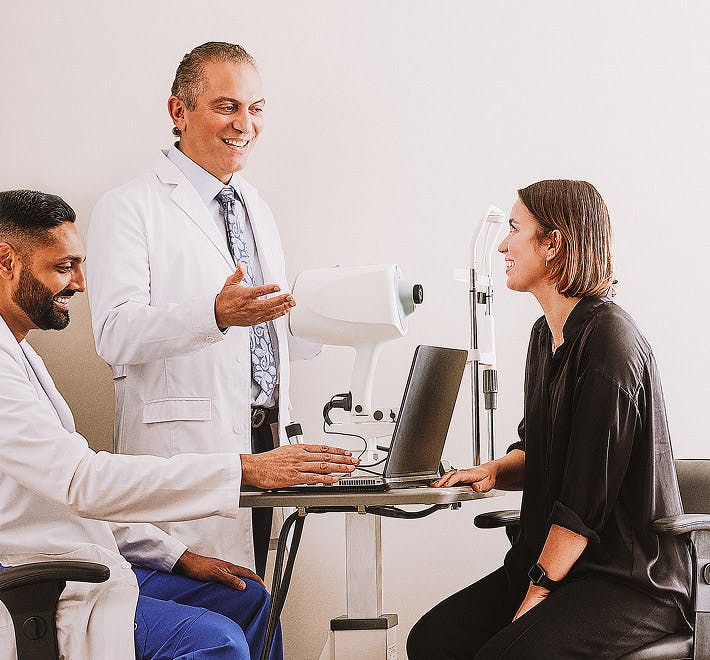Enhancing Your Vision
Guiding you toward the procedure that fits your unique needs, so you can see the world clearly and confidently.

Considering LASIK eye surgery? It’s a big decision that can significantly impact your vision and quality of life. To ensure you’re fully prepared and confident in your choice, it’s crucial to ask the right questions. Here are the top 10 questions I get asked that you should ask your LASIK eye surgeon for a successful procedure.
Understanding the LASIK procedure is essential for easing any concerns you might have. LASIK involves reshaping the cornea using a laser to correct vision. Before the surgery, your surgeon will apply numbing eye drops to ensure you don’t feel pain. Although you might experience some pressure, the procedure is generally quick and comfortable. Anesthesia is minimal, often just the numbing drops, allowing you to stay awake and responsive throughout the surgery.
Numbing the eye for LASIK is straightforward. Topical anesthetic eye drops are applied to your eyes a few minutes before the procedure. These drops effectively numb the surface of your eyes, preventing pain and ensuring comfort. Most patients only feel slight pressure or mild discomfort, making the process easy to tolerate.
Your surgeon might prescribe medications to ensure a smooth LASIK experience. This can include antibiotics to prevent infection and anti-inflammatory drugs to reduce swelling. Depending on your needs, you might also receive medication to help you relax during the procedure. Post-operatively, your surgeon will provide eye drops and possibly other medications to support healing and comfort.
While LASIK is a highly successful and safe procedure, it’s essential to be aware of potential risks and complications to make an informed decision. Common risks include dry eyes, glare, halos, and fluctuations in vision. These side effects are usually temporary and resolve within a few weeks or months as the eyes heal. However, in some cases, they can persist longer and require additional treatment. Dry eyes are the most common complication, occurring when the eyes do not produce enough tears after surgery. This can cause discomfort and blurry vision, but it is typically managed with artificial tears or prescription eye drops. Your LASIK surgeon will evaluate your tear production before surgery and provide recommendations to mitigate this risk.
Glare and halos around lights, especially at night, can affect night vision. These symptoms are usually temporary but can be more pronounced in patients with larger pupils. Advanced LASIK technologies, such as wavefront-guided LASIK, help reduce these visual disturbances by providing more precise corneal reshaping.
In rare cases, more severe complications can occur, such as infection, corneal flap issues, or undercorrection/overcorrection of vision. Your LASIK surgeon will take several precautions to minimize these risks, including using sterilized equipment, performing thorough pre-operative evaluations, and providing detailed post-operative care instructions.
Understanding these risks and discussing them with your surgeon can help you prepare for the procedure and ensure that any potential issues are promptly addressed, leading to a safer and more successful outcome.
Recovery from LASIK is relatively quick, with most patients noticing improved vision within a few days. Full recovery can take a few weeks, during which you’ll need to avoid activities that could strain your eyes, such as heavy lifting or swimming. Your surgeon will provide detailed post-operative care instructions to ensure a smooth recovery and optimal results.
LASIK results are long-lasting, with many patients enjoying clear vision for years. However, factors like aging and changes in your vision can impact the stability of your results. Some patients might require enhancements or follow-up procedures over time. Discussing the longevity of LASIK with your surgeon will help set realistic expectations.
You can read more about this in our post here: How Long Does LASIK Last?
The success rate of LASIK surgery is impressively high, with many patients achieving 20/20 vision or better. While advanced technology and precise techniques play crucial roles, the single most important factor in a successful outcome is the skill and experience of the surgeon. A highly experienced LASIK surgeon, like Dr. Ilan Cohen, brings expertise, precision, and personalized care to each procedure, significantly enhancing the chances of a successful result. Trusting a seasoned professional ensures you receive the highest standard of care, leading to optimal vision correction and patient satisfaction.
Certain medical conditions and eye health issues can impact your eligibility for LASIK. These include severe dry eyes, thin or irregular corneas, or autoimmune disorders. Your LASIK doctor will conduct a thorough evaluation to determine if you’re a suitable candidate. If any conditions are identified, they will discuss how these might affect your surgery and what steps can be taken to mitigate risks.
The cost of LASIK varies based on factors such as the technology used, the surgeon’s experience, and the location of the practice. On average, LASIK can range from $2,000 to $3,000 per eye. It’s important to discuss payment options, insurance coverage, and financing plans with your surgeon to make the procedure more affordable.
While LASIK is a popular and effective option for vision correction, it’s not suitable for everyone. There are several alternative procedures to consider:
Discussing these alternatives with your LASIK doctor can help you choose the best vision correction option based on your unique needs and lifestyle.
Guiding you toward the procedure that fits your unique needs, so you can see the world clearly and confidently.




If you do not see your preferred date and time please call the office, so we can accommodate your request (917) 398-4011.